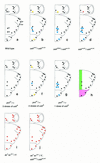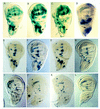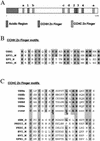u-shaped encodes a zinc finger protein that regulates the proneural genes achaete and scute during the formation of bristles in Drosophila
- PMID: 9367989
- PMCID: PMC316693
- DOI: 10.1101/gad.11.22.3083
u-shaped encodes a zinc finger protein that regulates the proneural genes achaete and scute during the formation of bristles in Drosophila
Abstract
The pattern of the large sensory bristles on the notum of Drosophila arises as a consequence of the expression of the achaete and scute genes. The gene u-shaped encodes a novel zinc finger that acts as a transregulator of achaete and scute in the dorsal region of the notum. Viable hypomorphic u-shaped mutants display additional dorsocentral and scutellar bristles that result from overexpression of achaete and scute. In contrast, overexpression of u-shaped causes a loss of achaete-scute expression and consequently a loss of dorsal bristles. The effects on the dorsocentral bristles appear to be mediated through the enhancer sequences that regulate achaete and scute at this site. The effects of u-shaped mutants are similar to those of a class of dominant alleles of the gene pannier with which they display allele-specific interactions, suggesting that the products of both genes cooperate in the regulation of achaete and scute. A study of the sites at which the dorsocentral bristles arise in mosaic u-shaped nota, suggests that the levels of the u-shaped protein are crucial for the precise positioning of the precursors of these bristles.
Figures







Similar articles
-
Different contributions of pannier and wingless to the patterning of the dorsal mesothorax of Drosophila.Development. 1999 Aug;126(16):3523-32. doi: 10.1242/dev.126.16.3523. Development. 1999. PMID: 10409499
-
The pronotum LIM-HD gene tailup is both a positive and a negative regulator of the proneural genes achaete and scute of Drosophila.Mech Dev. 2010 Sep-Dec;127(9-12):393-406. doi: 10.1016/j.mod.2010.05.001. Epub 2010 May 24. Mech Dev. 2010. PMID: 20580820
-
A major bristle QTL from a selected population of Drosophila uncovers the zinc-finger transcription factor poils-au-dos, a repressor of achaete-scute.Dev Biol. 2005 Dec 1;288(1):194-205. doi: 10.1016/j.ydbio.2005.09.032. Epub 2005 Oct 10. Dev Biol. 2005. PMID: 16216235
-
The complex tale of the achaete-scute complex: a paradigmatic case in the analysis of gene organization and function during development.Genetics. 2009 Jul;182(3):631-9. doi: 10.1534/genetics.109.104083. Genetics. 2009. PMID: 19622761 Free PMC article. Review.
-
The achaete-scute complex as an integrating device.Int J Dev Biol. 1998;42(3):275-82. Int J Dev Biol. 1998. PMID: 9654009 Review.
Cited by
-
Distinct domains of the GATA-1 cofactor FOG-1 differentially influence erythroid versus megakaryocytic maturation.Mol Cell Biol. 2002 Jun;22(12):4268-79. doi: 10.1128/MCB.22.12.4268-4279.2002. Mol Cell Biol. 2002. PMID: 12024038 Free PMC article.
-
Conserved microRNA miR-8 controls body size in response to steroid signaling in Drosophila.Genes Dev. 2012 Jul 1;26(13):1427-32. doi: 10.1101/gad.192872.112. Genes Dev. 2012. PMID: 22751499 Free PMC article.
-
Notch cooperates with Lozenge/Runx to lock haemocytes into a differentiation programme.Development. 2013 Feb;140(4):926-37. doi: 10.1242/dev.086785. Epub 2013 Jan 16. Development. 2013. PMID: 23325760 Free PMC article.
-
Enhancer-promoter communication mediated by Chip during Pannier-driven proneural patterning is regulated by Osa.Genes Dev. 2003 Mar 1;17(5):591-6. doi: 10.1101/gad.255703. Genes Dev. 2003. PMID: 12629041 Free PMC article.
-
The function role of GATA-3 in Th1 and Th2 differentiation.Immunol Res. 2003;28(1):25-37. doi: 10.1385/IR:28:1:25. Immunol Res. 2003. PMID: 12947222 Review.
References
-
- Bender W, Spierer P, Hogness DS. Chromosomal walking and jumping to isolate DNA from the Ace and rosy loci and the bithorax complex in Drosophila melanogaster. J Mol Biol. 1983;168:17–33. - PubMed
-
- Berg JM. Zinc finger proteins. Curr Opin Struct Biol. 1993;3:11–16.
Publication types
MeSH terms
Substances
Associated data
- Actions
LinkOut - more resources
Full Text Sources
Other Literature Sources
Molecular Biology Databases
